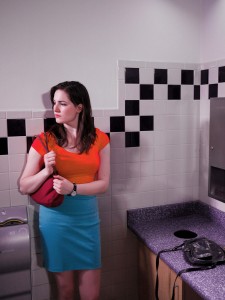If the walls of your high school bathroom could talk, they could probably tell you all you need to know about high school more than the halls ever could. While shy grazes between classes and aggressive shoves against the lockers can be very revealing about the high school experience, what is said behind closed doors—away from the hallway ruckus—can be just as illuminating. Under the pretty exterior is the ugly truth under the harsh light, and these revelations can differ depending on the person. In those few precious moments before class, in front of the bathroom mirror, every person is faced with the one thing that can be the difference between success and failure: themselves. Such moments provide the backdrop to Renée Roden's SHE, a production under Open Booth Theatre Company which explores the inner worlds of teenage girls, all within the confines of an actual bathroom located at Cristo Rey New York High School.
The third floor women's restroom is one which, despite its tiny space, signifies the oft-claustrophobic mind of a teenage girl. Indeed, from the moment one enters Cristo Rey, one is immediately inundated with images of various ways the media represents women, all plastered along the staircase walls leading up to the third floor landing. The claustrophobia sets in further once we are seated and left not only with a delayed, torturous silence, but also the silencing soundscape of our thoughts. As the title suggests, SHE centers around three female protagonists: the titular, intelligent She; the fun and gregarious Ryan, She's best friend; and Cassie, a talented ballet dancer and She's twin sister. In the privacy of the restroom, they worry about how their hair is behaving and whether they'll actually pass that AP Bio exam—and most importantly: whether any of them are going that party.
By all accounts and appearances, they seem like your average, everyday band of teenage girls. However, under the bright fluorescent light of their seemingly normal exterior world lies the stark harshness of their individual psyches. As each girl is left alone, we discover that while the three are vastly different, they each silently harbor the same problems. And interestingly enough, just as their personalities strike certain contrasts between them, so are each girl's ways of coping. She seeks solace in ritualistic perfection, reciting a mantra throughout the entirety of the play. Yale-hopeful Ryan finds comfort through numbers, made known through her use of a calorie-counting journal. Labyrinth-obsessed Cassie escapes through art—mainly dance, of course. "Everyone has to have somewhere that they go," she says at one point, as she does a private ballet solo to music from La Bayadère. "I think we all have one. A somewhere where we can go be by ourselves."
While the intriguing mention of a toilet-centric play definitely warrants a second glance, it is the powerful acting which completely leaves you in the play's thrall. Much of this is due to the strong performances delivered by the show's three leading ladies. Just as the play's three girls are living testaments of dichotomy, so are the three actresses. As She, Katherine Dudas walks the fine line between strength and vulnerability, a trait which makes itself known by play's end. For her part, Emily Dauer's Ryan balances her character's quippy one-liners with introspective observations about body image. Just like her character Cassie, Meaghan McLeod possesses a body of contradictions—at once both elegant and rough around the edges, in all her Bowie-inspired glory.
The small space also provides an interesting layer to the play's acting, with the actors not only periodically breaking the fourth wall, but also nearly "physically interacting" with the audience themselves. The lighting design utilizes dark, colored tones as the girls shift into their internal worlds, an effect that is powerful to watch. Similarly, the props design does an impressive job in suspending disbelief, by utilizing a few simple props to signify different locales such as the local Panera Bread and the house party. The use of music is equally important; songs such as John Mayer's "Your Body is a Wonderland" contrast with uptempo, Top 40s party anthems like Fifth Harmony's "Worth It," underscoring the play's recurring theme of appearances and society's pressures.
SHE examines the barriers between the private and the public selves—and whether a happy balance can be met. How many times have we tried to emulate that which isn't our actual self? Every day, as we are faced with these pressures, we often look to ourselves to blame. If we can lose that extra pound, make our lips plumper, or our hair silkier, we would stop hating the reflection staring back at us. However, it is only in looking outward and correcting society's standards instead that we can finally break through the barriers.
Open Booth Theatre Company's production of SHE ran at Cristo Rey New York High School (112 East 106th Street between Park and Lexington Aves.) from July 23 to Aug. 8. For more information on this and similar productions, visit http://www.openbooth.bpt.me.



